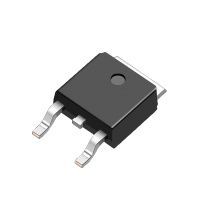NMOS vs. PMOS: Key Differences for Circuit Design
Date:2025-04-25 Categories:Product knowledge Hits:667 From:Guangdong Youfeng Microelectronics Co., Ltd
NMOS: Uses electrons as charge carriers, with an N-type channel formed on a P-type substrate. This design allows faster switching due to electrons’ higher mobility .
PMOS: Relies on holes (positive charge carriers) in a P-type channel on an N-type substrate. Holes have lower mobility, leading to slower operation but better compatibility with certain circuit configurations .
NMOS: Conducts when VGS (gate-source voltage) > threshold voltage (Vth), typically a positive value (e.g., 4V or 10V). Ideal for low-side switching (source grounded) .
PMOS: Conducts when VGS < Vth (negative voltage relative to source), suitable for high-side switching (source connected to VCC). However, its higher on-resistance (Rds(on)) limits efficiency in high-current applications .
Speed & Efficiency: NMOS outperforms PMOS in switching speed and power efficiency due to electrons’ faster movement. Its lower Rds(on) reduces conduction losses, making it ideal for high-frequency circuits .
Voltage Requirements: NMOS requires a positive gate voltage, while PMOS needs a negative one. This affects circuit complexity, especially in systems with single-supply voltages .
NMOS: Dominates in digital logic (e.g., CMOS circuits) and power management (e.g., DC-DC converters) due to its speed and low loss .
PMOS: Used in level-shifting and low-power analog designs, where negative voltage compatibility is critical. It also complements NMOS in CMOS logic to achieve low static power consumption .
At YFW, our
NMOS (e.g., YFW65R280AD) and
PMOS (e.g., YFW40P03DF) products combine high reliability with optimized performance. Our NMOS series excels in high-current applications, while PMOS solutions offer stable operation in demanding environments. Explore our
MOSFET portfolio for tailored solutions in consumer electronics, and industrial systems.
Stay tuned for more technical insights from YFW Microelectronics.

Previous:
Classification, Structure, and Principle of MOSFET
Next:
Preventing MOSFET Breakdown: Key Strategies for Reliable Operation
